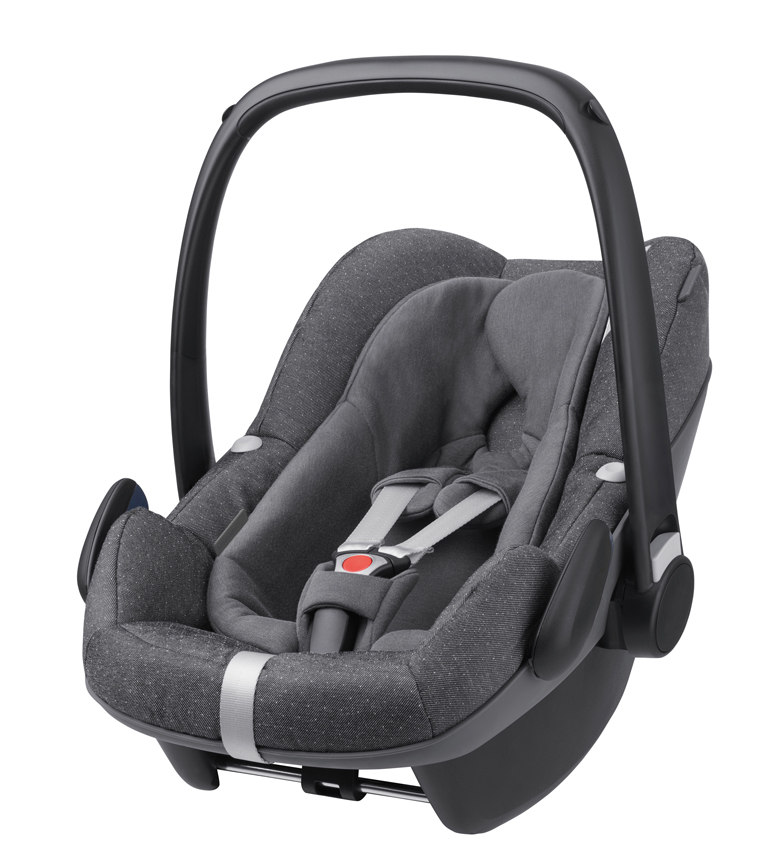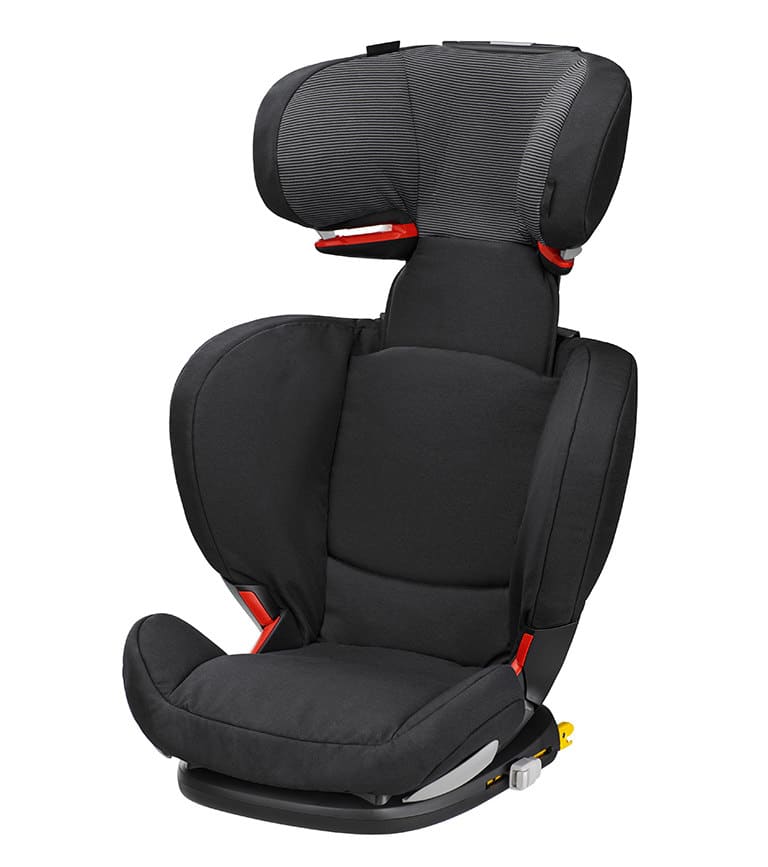Find the best child seat
Find the child seat that best suits your child’s requirements

From 0 to 13 kg (Group 0 and 0+) / From 40 to 87 cm and from 40 to 105 cm (i-Size)
- Up to approximately 2 years and heights up to 87 cm, and approximately 4 years for children up to 105 cm tall (weight and height are the determining factors rather than age)
- Purchase a child restraint system that is properly approved (R44/04 or R-129) and in a specialized center where you can be properly advised and allowed to test the child restraint in the car
- The child seat is installed on the rear seats and is rear facing.
- By law it can go on the front passenger seat only when the rear seats are occupied by other children in child seats, or if the car has no rear seats, or if it is impossible for a child restraint system to be installed on the back seats.
- If it is placed in the front passenger seat facing the rear, the airbag must be deactivated.
- Although the seat considered the safest is the center rear seat, as it is the one furthest from the doors, and therefore the one least affected by side impact, in most cars this seat does not have ISOFIX anchorages.
- Restraint systems with ISOFIX anchorages and anti-rotational systems are considered safer than devices that use seat belts for 2 reasons
- Ease of use and installation
- Increased child safety by reducing injuries.
- Therefore, given that the safety level of ISOFIX seats is better than seats that use seat belts, together with their ease of use and installation in the vehicle, we recommend the use of ISOFIX restraint systems, which should preferably be placed in the seat behind the front passenger, unless the central rear seat of the vehicle has ISOFIX anchorages. If our child restraint system is secured with the vehicle’s seat belt, we should preferably use the center rear seat.
- It can be installed using an ISOFIX system (244 KB) (if the car is equipped with this) or with safety belts. Follow the manufacturer’s instructions for proper installation.
- When the chair is ISOFIX, it will require the use of an anti-rotational system, a Support Leg, or a Top Tether (406 MB) .
- The inclination of the chair, especially in the case of baby carriers, should be as vertical as possible, without causing the baby’s head to fall forward. Normally this corresponds to about 35° of backrest inclination.
- Bassinets or carrycots may be used for newborns. These are installed crosswise on the rear seat, with the child’s head facing inwards. Only for the first few months. The use of this type of device is recommended for the shortest possible time, and mainly for medical reasons.
R-129
- The height and weight must be taken into account when choosing car seats approved under R-129.
- The child should be rear-facing up to 15 months of age. At Fundación MAPFRE we recommend doing so until the child is at least 4 years old.


From 9 to 18 kg (Group I) / up to 105 cm (i-Size)
- From approximately 8 months to 4 years of age (the weight and height of the child is what counts, not the age).
- Purchase a child restraint system that is properly approved (R44/04 or R-129) and in a specialized center where you can be properly advised and allowed to test the child restraint in the car.
- Child car seats i-Size 40 to 105 cm are for newborn babies up to 4 years of age approximately, while i-Size 61 to 105 cm are for babies from about 4 months to 4 years of age.
- Many child restraint systems in this segment are multi-group, and can be installed rear-facing, normally for babies from 40 to 105 cm, and facing forward, for babies from 76 to 105 cm .
- Children should be carried in a rear-facing position until they are 15 months old. At Fundación MAPRE we recommend that you do this until the child is 4 years old (105 cm).
- By law these child restraint systems can go on the front passenger seat only when the rear seats are occupied by other children in child seats, or if the car has no rear seats, or if it is impossible for a CRS to be installed on the rear seats.
- If a rear-facing child is in the passenger seat(due to one of the exceptions included in the regulations), it is compulsory to deactivate the front passenger airbag.
- It can be installed using an ISOFIX system (if the car is equipped with this), or with the seat belts. Follow the manufacturer’s instructions for proper installation.
- When the chair is ISOFIX, it will require the use of an anti-rotational system, a Support Leg, or a Top Tether.
- Although the seat considered the safest is the center rear seat, as it is the farthest from the doors, and therefore the one least affected by the impact in the event of a side impact, in most cars this seat does not have ISOFIX anchorages.
- Restraint systems with ISOFIX anchorages and anti-rotational systems are considered safer than devices that use seat belts for 2 reasons.
- Ease of use and installation
- Increased child safety by reducing injuries.
- Therefore, given that the safety level of ISOFIX seats is better than seats that use seat belts, together with their ease of use and installation in the vehicle, we recommend the use of ISOFIX restraint systems, which should preferably be placed in the seat behind the front passenger, unless the central rear seat of the vehicle has ISOFIX anchorages. If our child restraint system is secured with the vehicle’s seat belt, we should preferably use the center rear seat.
- The inclination of the chair, especially in the case of rear-facing seats, should be as vertical as possible, without causing the baby’s head to fall forward. Normally this corresponds to about 45° of backrest inclination. If we position the seat facing forward, we have to use the same criteria to ensure that the child’s head does not drop forwards due to the angle of the backrest.

From 15 to 36 kg (Group II-III) / more than 100 cm (i-Size booster seat / specific vehicle booster seat)
From approximately 3 to 12 years old (the weight and height of the child is what counts, not the age. From 100 cm to 150 cm in height).
- Booster seat with a backrest that allows the 3-point seat belt to be adapted to the restraint system.
- It must be installed on the rear seats (check the legislation), and it should be positioned on the central rear seat (390 KB).
- It is installed using the seat belt, although some child seats offer the possibility of accompanying this with the ISOFIX system (if the car is equipped with this). Follow the manufacturer’s instructions in order to correctly install the child car seat.
- The child is secured with the seat belt (961 MB): the diagonal belt should pass over the collarbone and over the shoulder without touching the neck and the horizontal belt should pass over the pelvis or upper thighs, never over the abdomen.
- Purchase a child restraint system that is properly approved (R44/04 or R-129) and in a specialized center where you can be properly advised and allowed to test the child restraint in the car
- A booster seat in Group 2-3 must have a backrest, whether it is approved under R44/04 or R-129. There are some boosters approved under R44 on the market that do not have a backrest, and provide no protection in the event of a side impact.


From 22 to 36 kg (Group III), for a child 125 to 150 cm tall
- From approximately 6 to 12 years of age (age is not the determining factor, weight and height are; from 125 cm to 150 cm).
- The child is too big for a child seat but has not yet reached the required height to wear only a seat belt.
- A booster seat without backrest with the purpose of lifting the child high enough to bring the lap belt across the pelvis or upper thighs, and the chest belt band across the collarbone, away from the neck.
- Since today’s vehicles have window airbags, in order to ensure that the booster seat offers a good level of safety even in side impacts, we must ensure that once the child is seated in the booster seat that their head height is greater than 770 mm.
- This criterion is valid for boosters approved under Regulation 44/04 and those approved under Regulation 129/03.
- It is advisable to use boosters only on journeys where the child does not fall asleep, because when this happens the backless booster is not able to ensure the correct position of the child in relation to the seat belt.
- They must go in the rear seats and face the direction of travel.
- Follow the manufacturer’s instructions in order to correctly install the child car seat and thread the seat belt through the indicated slots.
- It is very important to correctly position the seat belt: the horizontal strap should go over the pelvis (never over the abdomen), and the diagonal strap of the belt should pass over the middle part of the chest bone and collarbone (without touching the neck).
- Purchase a child restraint system that is approved and in a specialized center where they can answer any questions you may have and help you install the seat in the car.

Next step
Seat belt. When the child is above 36 kg or more than 150 cm tall. We recommend continuing to use restraint systems until the child is 150 cm tall and until the seat belt can be fitted correctly.
